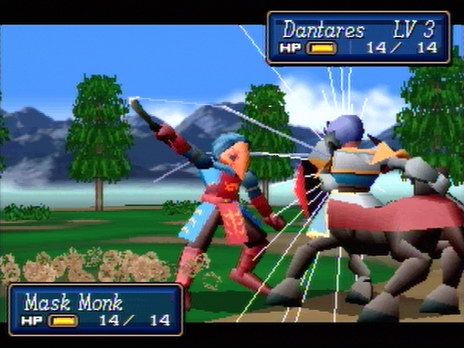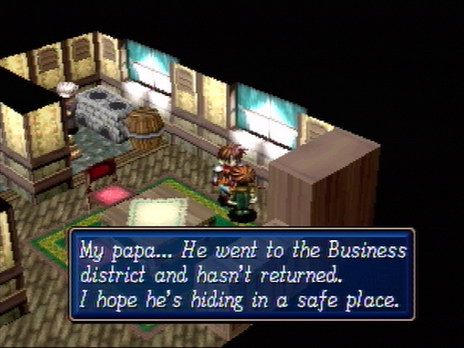Retro Replay Review
Gameplay
Shining Force III retains the series’ signature tactical role-playing formula, delivering grid-based combat that rewards careful planning and strategic foresight. As a young general thrust into a conflict of epic proportions, you must maneuver your units across varied battlefields—forests, plains, and castles—each terrain type influencing movement speed and defensive bonuses. The familiar rock-paper-scissors weapon triangle (swords best axes, axes best spears, spears best swords) remains intact, ensuring that positioning and weapon choice carry real weight in every skirmish.
One of the most notable new features in Shining Force III is the “Friendship” system, which deepens the bond between characters who fight side by side. When two units support or heal each other during battle, their friendship meter rises; once it reaches certain thresholds, these pairs begin to grant each other combat bonuses. This mechanic encourages you to think beyond individual tactics, prompting you to build cohesive teams whose combined strengths shine brightest when units protect and empower one another.
Outside of battles, the game flows like a traditional RPG: you explore towns, converse with NPCs, and scavenge dungeons for treasure. The narrative often branches based on your choices and who you bring along, adding replayability and nuance to character interactions. While exploration segments offer a more relaxed pace, they remain integral—clues gleaned in taverns or hidden items unearthed in caves can turn the tide in later conflicts.
Overall, the gameplay strikes a satisfying balance between accessibility and depth. Veterans of earlier Shining Force entries will find themselves right at home, yet newcomers are quickly drawn in by clear tutorials and steadily escalating challenge. Each chapter introduces new classes and magic spells, ensuring that progression never feels stale and battles remain engaging throughout the journey.
Graphics
Shining Force III was a visual leap for the franchise when it debuted, transitioning from purely 2D backdrops to fully rendered 3D environments. Battles take place on polygonal maps that rotate and zoom dynamically, offering multiple vantage points to study your units and the terrain. Character sprites themselves have been updated to low-polygon 3D models, lending a newfound sense of depth to animations and special attacks.
The cutscenes and story conversations still use classic 2D artwork, preserving that warm, hand–drawn aesthetic long cherished by series fans. Portraits of characters boast expressive line work and vibrant color palettes, seamlessly weaving together the old and new visual styles. Meanwhile, the battle animations—ranging from flashy sword slashes to arcane spells—are fluid and impactful, reminding you that this is still a Shining Force game at heart.
Terrain details, though simple by modern standards, remain clear and functional. Forests are dense with trees that offer visible cover, roads stretch out with engraved cobblestones, and castle interiors feel appropriately grand. While textures are modest and polygon counts low, the art direction ensures each map has its own identity and tactical significance without overwhelming the player.
Even more impressive is how well the game’s visuals hold up today. The crisp color schemes and thoughtfully designed UI elements feel timeless, and the overall presentation never distracts from the core strategic experience. For those playing on original hardware—or on a modern emulation setup—Shining Force III’s graphics deliver enough charm and clarity to satisfy both nostalgia seekers and newcomers alike.
Story
The narrative of Shining Force III kicks off with a high-stakes abduction: the Emperor has been kidnapped right from the heart of Saraband, and all evidence points to your liege lord as the mastermind. Forced to flee alongside the very monarch you aim to clear, you quickly discover that the political landscape is riddled with conspiracies, hidden motives, and shifting allegiances. What begins as a straightforward rescue mission becomes a multilayered saga of trust and betrayal.
From the opening scenes, the plot is peppered with morally gray decisions and surprising twists. Allies you once relied upon reveal ulterior motives, while former enemies occasionally lend crucial support. This ebb and flow of loyalty keeps you guessing, motivating you to build strong bonds with your core cast—both for battlefield bonuses and narrative closure. As truths about the Emperor’s disappearance come to light, you’re drawn deeper into a complex power struggle that affects the fate of the entire realm.
Character development is a standout strength. Each recruit has a distinct backstory and personal motivations that are explored through in-battle banter and interstitial cutscenes. You learn to understand why your mage harbors a vendetta, why the warrior hesitates on the frontlines, or why the thief might risk her life for a stranger. This emotional depth elevates routine missions into meaningful chapters in each character’s journey.
While the western release comprises only “Episode I,” the story offers a satisfying arc on its own—albeit tinged with cliffhangers. Fans have long lamented that Episodes II and III never saw an official localization, leaving many plot threads unresolved for western audiences. Still, as a standalone installment, it delivers intrigue, heart, and a world rich enough to spark the imagination.
Overall Experience
Shining Force III strikes a rare balance between old-school tactical RPG sensibilities and fresh innovations. The introduction of 3D environments and the friendship system breathes new life into the franchise without alienating series veterans. Battles feel weighty, and narrative choices carry real emotional stakes, making each chapter a rewarding test of both mind and heart.
The game’s pacing is well-judged: exploration sequences offer respite between major conflicts, while the steady introduction of new classes, spells, and mechanics ensures the challenge curve remains engaging. Despite the incomplete storyline in the western release, the characters you meet and the relationships you forge linger long after the credits roll—testament to the writing and design teams’ dedication.
Technically, the title holds up remarkably well. The art style sidesteps the dated pitfalls of early 3D, leaning on bold colors and clear silhouettes that remain readable even on smaller screens. Sound design and music complement the tone, from triumphant battle themes to quieter, atmospheric tracks during exploration.
For anyone with a fondness for strategic depth, memorable characters, and a sweeping fantasy narrative, Shining Force III is an essential play. Although you may crave closure on the story’s unanswered questions, the journey through Episode I alone offers countless hours of tactical battles, character-driven drama, and classic JRPG charm. It stands as a shining example of how to evolve a beloved series while staying true to its roots.
 Retro Replay Retro Replay gaming reviews, news, emulation, geek stuff and more!
Retro Replay Retro Replay gaming reviews, news, emulation, geek stuff and more!









Reviews
There are no reviews yet.